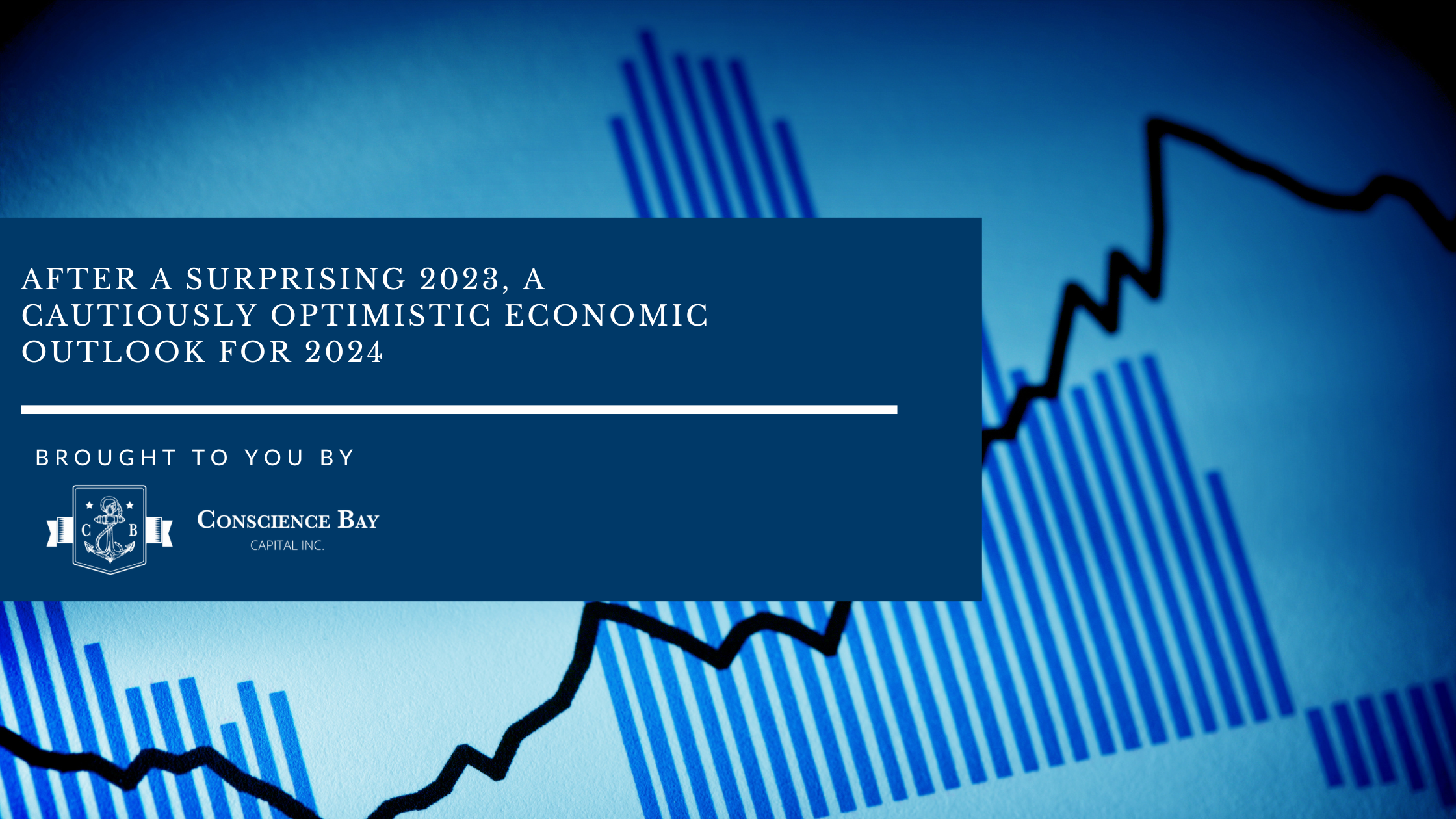After a Surprising 2023, a Cautiously Optimistic Economic Outlook for 2024
Submitted by Financial Investment Management | Conscience Bay Capital on January 3rd, 2024
Despite high interest rates and unsettling geopolitical conflict, the U.S. economy outperformed the expectations of most economists in 2023.1 Inflation-adjusted gross domestic product (Real GDP) accelerated to an annualized rate of 5.2% in the third quarter, after growing 2.1% in Q2 and 2.2% in Q1. Inflation, as measured by the 12-month change in the price index for personal consumption expenditures (PCE), was 3.0% in October 2023, after beginning the year at 5.5%.2 The labor market stayed strong in 2023, though it has cooled off a bit. The unemployment rate edged up from 3.4% in January to 3.9% in October, but is still quite low by historical standards.3
That is all good news considering that a majority of economists polled in January 2023 believed the United States would enter a recession by the end of the year.4 But whether you are an investor, a business owner, or an employee thinking about your career prospects, you may be more interested in what lies ahead for the economy in 2024. Economic projections are essentially educated guesses. Economists in the public and private sectors are tasked with trying to predict the future based on a wide range of indicators, potential risks, and their overall impressions of market conditions. And so far, forecasts for 2024 seem to suggest the economy is kicking off the new year in a more stable position.5
Fed policies and official forecasts
Since March 2022, the Federal Open Market Committee (FOMC) of the U.S. Federal Reserve has raised the benchmark federal funds rate aggressively in an effort to control inflation, which had climbed to its highest levels in 40 years.6–7 Raising interest rates is meant to slow economic activity by making it more expensive for consumers and businesses to borrow money, which discourages spending.
In November 2023, the Fed paused its rate hikes for the second meeting in a row, leaving the federal funds rate in a range of 5.25% to 5.5%, a 22-year high.8
Economic projections released at the FOMC's September meeting indicated that slower GDP growth is expected, with a median projection of 1.5% in 2024. This was an improvement from 1.1% in the previous forecast. The committee expected PCE inflation to continue declining and end the year at 2.5%, which would still be higher than the Fed's 2.0% target, and that the unemployment rate would tick up to 4.1% (based on median projections).9
Polling the pros
In October 2023, The Wall Street Journal's Economic Forecasting Survey found that a recession is no longer the consensus view of 65 top business and academic economists polled by the publication on a quarterly basis. On average, the group expects real GDP growth will slow to 1.0%, the unemployment rate will rise slightly to around 4.0%, and inflation (measured by the consumer price index) will fall to 2.4% by the end of 2024.10
Nearly 60% of the economists believed the Fed was finished hiking interest rates, and roughly half thought that rate cuts would begin in the second quarter of 2024, in response to signs of weakening growth.11
At the same time, some economists were still not convinced that the U.S. economy is out of the woods. As recently as November 2023, the Conference Board predicted that a very short and shallow recession will begin early in 2024.12
Global growth trends
According to the Organisation for Economic Co-operation and Development's September forecast, the global economy is expected to grow 3.0% in 2023 before slowing to 2.7% in 2024. In China, the growth rate is forecast to weaken from 5.1% in 2023 to 4.6%, due to its struggling property market and reduced domestic demand. Growth in the Euro area is expected to improve from 0.6% in 2023 to 1.1% in 2024. Inflation is expected to decline gradually, but to remain above central bank objectives in most economies.13
The problem with projections
Forecasts such as these may be helpful in making some kinds of financial decisions, but it's also important to consider their limitations and remember that it's not unusual for economists to change their minds. Recent years have shown how difficult it can be for forecasters to account for the impact of unforeseen economic disruption. Wild cards that could test economists in 2024 include losses from severe weather, fluctuations in oil prices, political conflict in the United States, and expansion of the war in Israel, which could harm an already fragile global economy.
In fact, Fed Chair Jerome Powell called on Fed forecasters to remain flexible in his November 2023 press conference. "Of course, even with state-of-the-art models and even in relatively calm times, the economy frequently surprises us." He continued, "Our economy is flexible and dynamic, and subject at times to unpredictable shocks, such as a global financial crisis or a pandemic. At those times, forecasters have to think outside the models."14
The financial markets could continue to react — and occasionally overreact — to economic news and policies announced by the Federal Reserve. But that doesn't mean you should do the same. As always, it's important to maintain a long-term perspective and invest strategically based on your financial goals, time horizon, and risk tolerance.
Forecasts are based on current conditions, are subject to change, and may not come to pass. All investments are subject to market fluctuation, risk, and loss of principal. When sold, investments may be worth more or less than their original cost.
1, 4–5, 10–11) The Wall Street Journal Economic Forecasting Survey, 2022–2023
2, 7) U.S. Bureau of Economic Analysis, 2023
3) U.S. Bureau of Labor Statistics, 2023
6, 8–9) Federal Reserve, 2023
12) The Conference Board, 2023
13) Organisation for Economic Co-operation and Development, 2023
14) thehill.com, November 8, 2023
Important Disclosures:
This article was prepared by Broadridge.
LPL Tracking #513474

